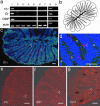Olfactory expression of a single and highly variable V1r pheromone receptor-like gene in fish species
- PMID: 15809442
- PMCID: PMC556222
- DOI: 10.1073/pnas.0402581102
Olfactory expression of a single and highly variable V1r pheromone receptor-like gene in fish species
Abstract
Sensory neurons expressing members of the seven-transmembrane V1r receptor superfamily allow mice to perceive pheromones. These receptors, which exhibit no sequence homology to any known protein except a weak similarity to taste receptors, have only been found in mammals. In the mouse, the V1r repertoire contains >150 members, which are expressed by neurons of the vomeronasal organ, a structure present exclusively in some tetrapod species. Here, we report the existence of a single V1r gene in multiple species of a non-terrestrial, vomeronasal organ-lacking taxon, the teleosts. In zebrafish, this V1r gene is expressed in chemosensory neurons of the olfactory rosette with a punctate distribution, strongly suggesting a role in chemodetection. This unique receptor gene exhibits a remarkably high degree of sequence variability between fish species. It likely corresponds to the original V1r present in the common ancestor of vertebrates, which led to the large and very diverse expansion of vertebrate pheromone receptor repertoires, and suggests the presence of V1rs in multiple nonmammalian phyla.
Figures



References
-
- Buck, L. & Axel, R. (1991) Cell 65, 175–187. - PubMed
-
- Ryba, N. J. & Tirindelli, R. (1997) Neuron 19, 371–379. - PubMed
-
- Matsunami, H. & Buck, L. B. (1997) Cell 90, 775–784. - PubMed
-
- Herrada, G. & Dulac, C. (1997) Cell 90, 763–773. - PubMed
-
- Speca, D. J., Lin, D. M., Sorensen, P. W., Isacoff, E. Y., Ngai, J. & Dittman, A. H. (1999) Neuron 23, 487–498. - PubMed
Publication types
MeSH terms
Substances
Associated data
- Actions
- Actions
- Actions
- Actions
- Actions
- Actions
- Actions
- Actions
- Actions
- Actions
- Actions
LinkOut - more resources
Full Text Sources
Molecular Biology Databases

